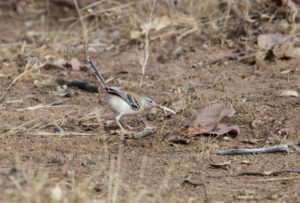 The Cricket Warbler or Cricket Longtail (Spiloptila clamans) is another excellent contribution to the portfolio of Western Palearctic birds for bird-lens.com. Although only recently encountered inside the boundary of the Western Palearctic this cute, small bird native to the Sahel region is highly welcome.
The Cricket Warbler or Cricket Longtail (Spiloptila clamans) is another excellent contribution to the portfolio of Western Palearctic birds for bird-lens.com. Although only recently encountered inside the boundary of the Western Palearctic this cute, small bird native to the Sahel region is highly welcome.
In April 2017, bird-lens.com went on a Rockjumper-tour to bird northern Cameroon. Coming from Waza NP on 10th of April, we arrived at Mora by early morning. The fields for birds were along the road just a few kilometres north of Mora. The small agriculture is done on a very sandy place. First the much-wanted Quail Plover or Lark Buttonquail (Ortyxelos meiffrenii) was on everybody’s mind, and we turned our attention to this species first. Although we started our walk at 7:15 AM, a long, hot walk expected us. Soon we were striding purposefully across the parched Sahelian landscape. We had to work hard, lining up and scanning the area. First we saw a Scissor-tailed Kite (Chelictinia riocourii) circling low over our hats, a handful of Black-headed Lapwing (Vanellus tectus) and good numbers of Black Scrub-Robins (Cercotrichas podobe).
Shortly after we spotted a very smart pair of Cricket Longtail in the low, thorny shrubbery. A short while after, another single Cricket Longtail was noted; it was restless and moved from one bush to another. The Cricket Longtails stayed mainly in Acacia bushes. The birds were flying around following each other from one low Acacia bush to another. In the short moment perched on a branch, they move their tails jerkily up and down and side to side, while making its monotonous cricket like call. Only rarely we saw the bird singing from a high perch in the top of a tree. Cricket Longtails feed on insects which are often searched for low down in thorn scrub. An adult female was seen on the ground with a big cricket. Unfortunately these were the only Cricket Longtails we observed.
Cricket Longtail is breeding in a belt throughout northern Africa. Its population limits are restricted to a narrow band stretching from southern Mauritania and northern Senegal eastwards to Mali, Niger, Chad, Sudan, Ethiopia and Eritrea. The species has recently been discovered in Oued Jenna some 40 Km in front of the village of Aousserd in the Region of Oued Dahab. Before the discovery the species has not been recorded in the WP apart from northern Mauritania.
Due to the geopolitical situation of the region, the southernmost Western Sahara, bird-lens.com decided to use a Rockjumper-tour to bird northern Cameroon instead of visiting one of the less birded areas in the WP. With the political circumstance stabilized, the opportunities of visiting might increase.
Cameroon sightings might benefit from the fact, that Cricket Longtail are said to be partially migratory in the Sahel zone, especially at the northern edge of the range. Some Cricket Longtail move south from the northern Sahel zone in the dry season (March/ April until September in Western Sahara), returning north during the rains (November until February) Cameroon has two seasons. The rainy season begins in April and ends in November. This would support, that
In order to satisfy the growing demand for top shots of the rarer species of Palearctic, Bird-lens.com has undertaken targeted travel to near and distant bird areas. This is to be able to do anything to provide excellent images of the birds of the Western Palearctic. The results in images even of rare Western Palearctic birds are very good. Very nice images bird-lens.com could bring back home among others from Europe from Scandinavia (Norway, Sweden, Finland, Denmark), from Holland, from England, Poland, Austria, France, Portugal, Spain and of course from Germany.
The beautiful image of the blog is only first impressions of what you will find in behind “Picture Shop” very soon. Simply contact bird-lens.com if you need an image of a bird before even more new pictures are online.